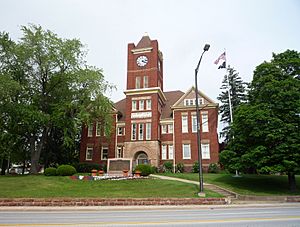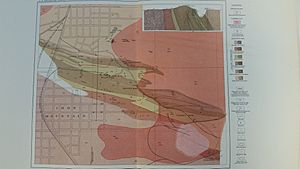Iron Mountain, Michigan facts for kids
Quick facts for kids
Iron Mountain, Michigan
|
|
|---|---|
| City of Iron Mountain | |
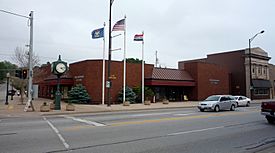
Iron Mountain City Hall
|
|
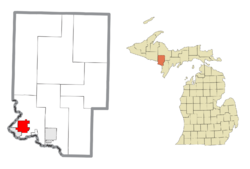
Location within Dickinson County
|
|
| Country | United States |
| State | Michigan |
| County | Dickinson |
| Settled | 1878 |
| Incorporated | 1887 (village) 1889 (city) |
| Government | |
| • Type | Council–manager |
| Area | |
| • Total | 8.21 sq mi (21.27 km2) |
| • Land | 7.54 sq mi (19.53 km2) |
| • Water | 0.67 sq mi (1.73 km2) |
| Elevation | 1,138 ft (347 m) |
| Population
(2020)
|
|
| • Total | 7,518 |
| • Density | 997.08/sq mi (384.97/km2) |
| Time zone | UTC-6 (Central (CST)) |
| • Summer (DST) | UTC-5 (CDT) |
| ZIP code(s) |
49801, 49802, 49831
|
| Area code(s) | 906 |
| FIPS code | 26-40960 |
| GNIS feature ID | 0629079 |
Iron Mountain is a city in Michigan, located in the state's Upper Peninsula. It is the main city of Dickinson County. The city was named Iron Mountain because of the valuable iron ore found nearby.
In 2020, about 7,518 people lived in Iron Mountain. The city is known for its interesting places like the Millie Hill bat cave and the Chapin Mine Steam Pump Engine. It is also next to the Pine Mountain Jump, which is one of the biggest man-made ski jumps in the world.
Iron Mountain is famous for its pasties (a type of savory pastry), bocce ball tournaments, and World Cup ski jumps. Famous people like Michigan State University basketball coach Tom Izzo and former NFL coach Steve Mariucci grew up here.
Contents
Exploring Iron Mountain's Location
Iron Mountain is located in the Upper Peninsula. It covers an area of about 8 square miles (21 square kilometers). Most of this area is land, with a small part being water.
Understanding the Population of Iron Mountain
| Historical population | |||
|---|---|---|---|
| Census | Pop. | %± | |
| 1890 | 8,599 | — | |
| 1900 | 9,242 | 7.5% | |
| 1910 | 9,216 | −0.3% | |
| 1920 | 8,251 | −10.5% | |
| 1930 | 11,652 | 41.2% | |
| 1940 | 11,080 | −4.9% | |
| 1950 | 9,679 | −12.6% | |
| 1960 | 9,299 | −3.9% | |
| 1970 | 8,702 | −6.4% | |
| 1980 | 8,341 | −4.1% | |
| 1990 | 8,525 | 2.2% | |
| 2000 | 8,154 | −4.4% | |
| 2010 | 7,624 | −6.5% | |
| 2020 | 7,518 | −1.4% | |
| U.S. Decennial Census | |||
Population in 2010
In 2010, Iron Mountain had 7,624 people living in 3,362 homes. About 28% of these homes had children under 18. Most people in the city were White (96.3%). The average age of people in Iron Mountain was 42.4 years.
News and Entertainment in Iron Mountain
Local Newspaper
The main newspaper for Dickinson County is The Daily News.
Television Channels
Iron Mountain is part of the Marquette television area. A local news office for the NBC channel WLUC covers news from Iron Mountain and nearby places. Because of the distance and hills, it can be hard to get TV signals directly from antennas.
Radio Stations
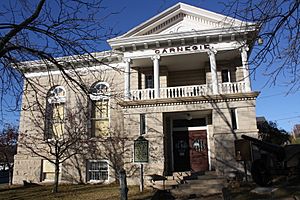
Many radio stations can be heard in Iron Mountain, offering different types of music and shows:
- WNMU-FM 90.1 FM – From Marquette, plays National Public Radio programs.
- WMVM-FM 90.7 FM – Plays Gospel music.
- WVCM 91.5 FM – A religious station.
- WIMK 93.1 FM – Plays Classic Rock.
- WZNL 94.3 FM – Plays Adult Contemporary music.
- WEUL 98.1 FM – Another religious station.
- WIKB-FM 99.1 FM – Plays Oldies music.
- WOBE 100.7 FM – Plays Top 40/CHR music.
- WJNR-FM 101.5 FM – Plays Country music.
- WGMV 106.3 FM – Plays Classic Country music.
- WHTO 106.7 FM – Plays 80s Rock music.
- WFER 1230 AM – Plays Oldies music.
- WMIQ 1450 AM – A Talk radio station.
Important Natural Features
The abandoned Millie Hill mine in Iron Mountain is a very important place for bats. It's one of the biggest bat hibernacula (places where bats sleep through winter) in the Midwest. Thousands of bats used to live there in winter. Sadly, a bat disease has caused many of them to die.
The Menominee Iron-Bearing District
Iron Mountain is in an area called the Menominee Iron-Bearing District. This is where iron ore was first found in 1849. The iron ore comes from special rock layers that are very old, formed billions of years ago. These layers contain minerals like hematite and magnetite, which are used to make iron.
Getting Around Iron Mountain
Bus Services
You can travel by bus from Iron Mountain to other cities like St. Ignace and Ironwood using Indian Trails bus service.
Main Roads
 US 2 goes east to Escanaba and west to Ironwood.
US 2 goes east to Escanaba and west to Ironwood. US 141 joins US 2 east of the city. It goes north towards Crystal Falls and south to Green Bay, Wisconsin.
US 141 joins US 2 east of the city. It goes north towards Crystal Falls and south to Green Bay, Wisconsin. M-95 connects to Kingsford to the south and M-69 to the north.
M-95 connects to Kingsford to the south and M-69 to the north.
Airport Access
The Ford Airport (KIMT) serves the Iron Mountain area. You can fly with SkyWest Airlines, which operates as Delta Connection. The airport is three miles west of the city and has two runways.
Train History
When Iron Mountain was first settled, railroads came because of the rich mineral discoveries. Companies like Milwaukee Road, Chicago & Northwestern, and Wisconsin & Michigan Railway all had lines here. However, as cars became more popular in the 1950s, people stopped using trains as much. Passenger train service to Iron Mountain ended in the 1960s. Today, there are no direct passenger trains, but you can connect to bus services that link to Amtrak trains in other cities.
Famous People from Iron Mountain
Many notable people have come from Iron Mountain:
- James L. Adams, a member of the Minnesota House of Representatives.
- Randy Awrey, a football player and coach.
- John Biolo, a former NFL player for the Green Bay Packers.
- Neno DaPrato, a college and professional football player.
- Robert J. Flaherty, a famous filmmaker.
- Walter Samuel Goodland, a former governor of Wisconsin.
- R. James Harvey, a former congressman and federal judge.
- John Hubley, an Academy Award-winning animated film director.
- Tom Izzo, the head coach for Michigan State University men's basketball.
- Johnny Johnson, a baseball player.
- Beau LaFave, a member of the Michigan House of Representatives.
- Gordon Lund, a baseball player.
- Steve Mariucci, an NFL Network analyst and former NFL head coach.
- Thomas Lawrence Noa, a Roman Catholic bishop.
- Phillip Rahoi, a member of the Michigan Legislature and former mayor of Iron Mountain.
- Gene Ronzani, a former NFL head coach for the Green Bay Packers.
- Albert J. Wilke, a member of the Michigan Senate.
- Delaney Schnell, an American Olympic diver.
Iron Mountain's Climate
Iron Mountain has a humid continental climate. This means it has big changes in temperature throughout the year. Summers are warm to hot and often humid, while winters are cold, sometimes very cold.
| Climate data for Iron Mountain WWTP, Michigan (1991–2020 normals, extremes 1899–present) | |||||||||||||
|---|---|---|---|---|---|---|---|---|---|---|---|---|---|
| Month | Jan | Feb | Mar | Apr | May | Jun | Jul | Aug | Sep | Oct | Nov | Dec | Year |
| Record high °F (°C) | 57 (14) |
62 (17) |
82 (28) |
94 (34) |
100 (38) |
100 (38) |
104 (40) |
101 (38) |
98 (37) |
88 (31) |
77 (25) |
64 (18) |
104 (40) |
| Mean maximum °F (°C) | 41.4 (5.2) |
48.0 (8.9) |
61.5 (16.4) |
74.8 (23.8) |
85.3 (29.6) |
90.8 (32.7) |
91.3 (32.9) |
89.7 (32.1) |
85.3 (29.6) |
77.2 (25.1) |
59.4 (15.2) |
46.1 (7.8) |
93.7 (34.3) |
| Mean daily maximum °F (°C) | 24.0 (−4.4) |
28.3 (−2.1) |
39.2 (4.0) |
51.9 (11.1) |
66.4 (19.1) |
76.0 (24.4) |
80.4 (26.9) |
78.3 (25.7) |
70.1 (21.2) |
55.7 (13.2) |
40.8 (4.9) |
29.0 (−1.7) |
53.3 (11.8) |
| Daily mean °F (°C) | 14.2 (−9.9) |
17.2 (−8.2) |
28.0 (−2.2) |
40.5 (4.7) |
54.1 (12.3) |
64.0 (17.8) |
68.5 (20.3) |
66.7 (19.3) |
58.6 (14.8) |
45.3 (7.4) |
32.5 (0.3) |
20.9 (−6.2) |
42.5 (5.8) |
| Mean daily minimum °F (°C) | 4.4 (−15.3) |
6.1 (−14.4) |
16.9 (−8.4) |
29.0 (−1.7) |
41.7 (5.4) |
52.0 (11.1) |
56.6 (13.7) |
55.1 (12.8) |
47.0 (8.3) |
34.9 (1.6) |
24.2 (−4.3) |
12.8 (−10.7) |
31.7 (−0.2) |
| Mean minimum °F (°C) | −16.9 (−27.2) |
−16.1 (−26.7) |
−6.9 (−21.6) |
14.1 (−9.9) |
27.0 (−2.8) |
37.0 (2.8) |
44.5 (6.9) |
42.4 (5.8) |
32.0 (0.0) |
22.1 (−5.5) |
8.0 (−13.3) |
−8.4 (−22.4) |
−20.8 (−29.3) |
| Record low °F (°C) | −35 (−37) |
−39 (−39) |
−27 (−33) |
−6 (−21) |
16 (−9) |
24 (−4) |
35 (2) |
30 (−1) |
19 (−7) |
8 (−13) |
−10 (−23) |
−26 (−32) |
−39 (−39) |
| Average precipitation inches (mm) | 1.36 (35) |
1.15 (29) |
1.68 (43) |
2.79 (71) |
3.48 (88) |
3.71 (94) |
3.41 (87) |
3.38 (86) |
3.60 (91) |
3.27 (83) |
1.90 (48) |
1.76 (45) |
31.49 (800) |
| Average snowfall inches (cm) | 14.7 (37) |
11.2 (28) |
8.9 (23) |
7.1 (18) |
0.2 (0.51) |
0.0 (0.0) |
0.0 (0.0) |
0.0 (0.0) |
0.0 (0.0) |
0.4 (1.0) |
5.5 (14) |
13.0 (33) |
61.0 (155) |
| Average extreme snow depth inches (cm) | 14.8 (38) |
17.9 (45) |
15.1 (38) |
6.1 (15) |
0.1 (0.25) |
0.0 (0.0) |
0.0 (0.0) |
0.0 (0.0) |
0.0 (0.0) |
0.5 (1.3) |
3.3 (8.4) |
9.2 (23) |
19.8 (50) |
| Average precipitation days (≥ 0.01 in) | 10.1 | 6.9 | 7.7 | 10.1 | 12.0 | 11.5 | 11.6 | 10.6 | 11.3 | 11.7 | 8.9 | 9.6 | 122.0 |
| Average snowy days (≥ 0.1 in) | 9.8 | 6.3 | 4.9 | 2.8 | 0.2 | 0.0 | 0.0 | 0.0 | 0.0 | 0.5 | 3.8 | 8.0 | 36.3 |
| Source: NOAA | |||||||||||||
See also
 In Spanish: Iron Mountain (Míchigan) para niños
In Spanish: Iron Mountain (Míchigan) para niños




